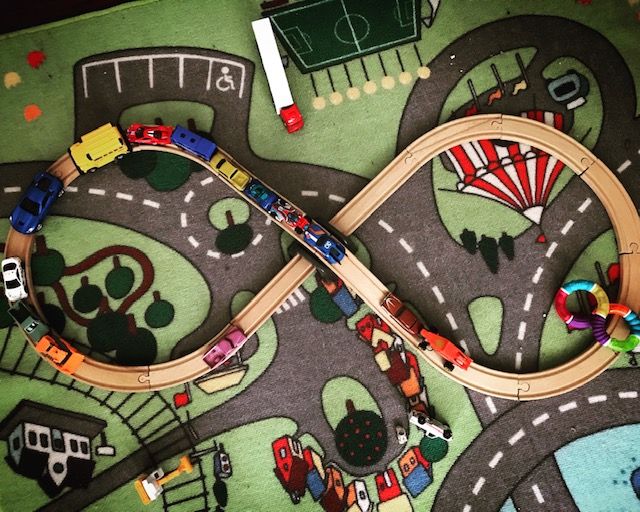Infinity and Me by Kate Hosford & Gabi Swiatkowska

When D came down with the flu last month ahead of the Thanksgiving weekend, we headed to the library and returned home armed with a set of eight books. Of these, I picked up one knowing it was likely fairly above D’s reading/comprehension level but it was I who wanted to savour the story.
In all my readings, I make sure D knows who the author and the illustrator are. Even in later references to the books we read, the name of each book as we utter it include the title alongside the names of the author and illustrator. Many books bear snapshots of their authors and illustrators on the inside of the back cover, and D is just as intrigued with these images as he is with every detail in all the other pages. So the first few times I introduced the book to D, we didn’t move beyond the cover page. He was tickled to bits at my pronunciation of “Swiatkowska” and asked me to repeat it endlessly.
A day before he turned 28 months old, D finally sat through an entire reading of the story. It’s a beautiful tale of 8-year old Uma who ponders the meaning of infinity. The question stumps and confuses her, and the answers she seeks from her friends and family often add to her bewilderment or offer only silvers of comfort. In the end, she is assuaged by the realisation that infinity can be represented in several ways, and that one of them is love.
One of D’s favourite bits is an explanation offered by Uma’s best friend, Samantha, who shows her the symbol of infinity and says it looks as if the number 8 had fallen over for a nap.
And just the other day, we realised that the D’s railway track and a teether from a very long ago are also shaped like infinity! (And I simply can’t get over D’s use of the rail track as a route/parking spot for his road vehicles!)

Did you know the symbol for infinity is actually called a “lemniscate”? Lemniscate is also a code word that appears in the Canadian TV series, Murdoch Mysteries. Dr. Julia Ogden, while undergoing hormonal therapy, says “lemniscate” to indicate to her husband, Detective William Murdoch, that the moment is right for them to fool around and try to conceive a baby!
D is also taken with the “so many 8’s” that appear on one of the pages in which Gabi portrays an infinite number limited by the bounds of the page. D recognises 0 to 9, and can count up to 20, which he pronounces as an endearing “ten-teen”. The other day he asked us to show him what the written version of 10 looks like. When we did, he responded with, “No 1, no 0, want 10”.
Swiatkowska’s illustrations are very clever and intriguing. They look like images from a very old black and white movie in which some colour managed to sneak through, with dark undertones that reflect Uma's confusion, and the colours, when they appear, are not jarring but are soft and serene. Of course, there’s also the bright red of Uma’s new shoes.
The dedication page bears the portrait of a lady who looks remarkably similar to Swiatkowska whose picture appears at the end of the book. And D was quick to notice that this portrait also appears in the middle of the story as part of the series of family portraits. Hosford also dedicates the book to “Gabi”. Things like these make me wonder about the backstory of these stories, the secrets and private jokes hidden in these images and words that will never be privy to anyone but the writer and the illustrator.
Spread across a double page is a series of images that shows Uma wondering what it would be like if she could be 8 years old forever. But then Samantha would grow up and what would an 85-year-old Samantha and an 8-year-old Uma have in common? A set of 6 images show Samantha at different stages of her life, from toddlerhood to old age, with corresponding images of Uma stuck at 8, looking bewildered and somehow left behind.
“So many Sampanas,” noted D.
“Well, it’s the same Samantha,” I said. “She’s growing up.”
“So many Sampanas,” he insisted.
“Yes, many different Samantha’s. Look, here she’s a little child, then she’s a big child in this one, she’s going to school in this one, she’s become a doctor, and then she becomes a Mumma, and finally a grandma.”
It was D’s turn to look bewildered now. I changed tack.
“See you are a little child now, someday you will also be a big child, then you’ll be a man, then maybe you’ll become a Dada, and then a Grandpa.”
“Man now,” D demanded.
“Well, it will take a long time, sweetie. It will take years. And then maybe you’ll also become a Dada and then a Grandpa.”
“Mumma?”
“Do you want to be like Mumma?”
“Yes.” A shy smile.
“Oh sweetie! You are you. A very special you.” And I’m not even half the person you already are.
An afterthought.
“No school,” D said. This is something that he sneaks into conversations every half an hour or so at home. His reluctance to go to school has only increased since his first day there. “Baby misses Mumma in school,” is the reason he offers for not wanting to go to school.
“There’s no school now sweetie,” I say. “It’s bedtime.”
“No school.” He was pointing to the image of Samantha carrying books and a bag, an image from the set of 6 that I had pointed out to him as school-going Samantha.
“Oh, do you mean Samantha is not going to school in this picture?”
“Yes. Not going to school.”
“Ok!”